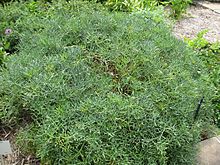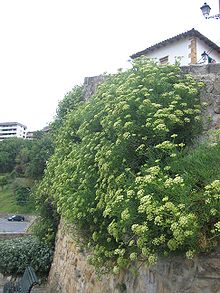- Crithmum
-
For other uses of the name samphire, see Samphire.
Rock samphire 
Scientific classification Kingdom: Plantae (unranked): Angiosperms (unranked): Eudicots (unranked): Asterids Order: Apiales Family: Apiaceae Genus: Crithmum Species: C. maritimum Binomial name Crithmum maritimum
L.Samphire or rock samphire, Crithmum maritimum, is the sole species of the genus Crithmum. It is an edible wild plant found on southern and western coasts of Britain and Ireland, on mediterranean and western coasts of Europe including the Canary Islands, North Africa and the Black Sea. The term samphire is used for several unrelated species of coastal plant.
Contents
History, trade and cultivation
In the 17th century, Shakespeare referred to the dangerous practice of collecting rock samphire from cliffs. "Half-way down, Hangs one that gathers samphire; dreadful trade!"[1] In the 19th century, samphire was being shipped in casks of seawater from the Isle of Wight to market in London at the end of May each year.[2] Rock samphire used to be cried in London streets as "Crest Marine".[3]
In England, rock samphire was cultivated in gardens,[4] where it grows readily in a light, rich soil. Obtaining seed commercially is now difficult, and in the United Kingdom the removal of wild plants is illegal under the Wildlife and Countryside Act 1981.
The reclaimed piece of land adjoining Dover, called Samphire Hoe, is named after rock samphire. The land was created from spoil from the Channel Tunnel, and rock samphire used to be harvested from the neighbouring cliffs.
Culinary use
Rock samphire has fleshy, divided aromatic leaves that Culpeper described as having a "pleasant, hot and spicy taste"[5]
The stems, leaves and seed pods may be pickled in hot, salted, spiced vinegar, or the leaves used fresh in salads.
Richard Mabey gives several recipes for samphire,[6] although it is possible that at least one of these may refer to marsh samphire or glasswort (Salicornia europaea), a very common confusion.
References
- ^ Shakespeare, William (1623). The Tragedy of King Lear. London. Act IV, scene VI, lines 14b-15
- ^ Grigson, Geoffrey (1958). The Englishman's Flora. London: The Readers' Union, Phoenix House.
- ^ Phillips, Roger (1983). Wild Food. Pan. ISBN 0330280694.
- ^ Phillips, Roger (1983). Wild Food. Pan. ISBN 0330280694.
- ^ Culpeper, Nicholas (1653). The Complete Herbal. London.
- ^ Mabey, Richard (1975). Food For Free. Fontana. ISBN 000613470X.
External links
- BBC Gardeners' Question Time – where there is apparently some confusion between the glasswort (marsh samphire, found in Suffolk) and the rock samphire (found in Dorset).
- Biff Vernon discusses the common confusion between marsh samphire and rock samphire, and reproduces a poem on the subject by William Logan.
- Botanical.com
- Riverhouse
Edible Apiaceae Ajwain • Alepidea peduncularis • Alexanders • Anise • Anthriscus sylvestris • Apium prostratum • Arracacha • Asafoetida • Bunium persicum • Caraway • Carrot • Celeriac • Celery • Centella asiatica • Chaerophyllum bulbosum • Chervil • Cicely • Coriander • Crithmum • Cryptotaenia • Cumin • Daucus pusillus • Dill • Echinophora sibthorpiana • Erigenia bulbosa • Eryngium foetidum • Fennel • Garden Angelica • Ground-elder • Heracleum persicum • Lomatium • Lomatium parryi • Lovage • Masterwort • Oenanthe javanica • Osmorhiza • Parsley • Parsnip • Perideridia • Radhuni • Ridolfia segetum • Sium sisarum
Categories:- Edible Apiaceae
- Leaf vegetables
- Stem vegetables
- Halophytes
- Apiaceae stubs
- Vegetable stubs
Wikimedia Foundation. 2010.


